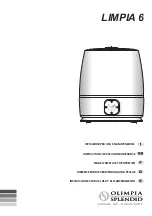
14
Overcharged System
Operate the unit for at least 30 minutes in a room
temperature of 75°F to 85°F. The top of the compressor
should be warm to the touch. This applies to a recipro-
cating compressor only. If it is cool or cold, the system
is possibly overcharged. On models eqipped with
Rotary compressors, check for frost or cold tempera-
tures all the way to the top of the accumulator.
An overcharged system must be evacuated and
recharged. Purging off excess refrigerant is not legal or
practical, as there is no way of determining the amount
to purge.
Pressure Equalizing (System Unloading)
If an attempt is made to start the unit too soon after it has
stopped, the compressor may fail to start and will cycle
on the overload protector. This is caused by high head
pressure and low suction pressure. Allow the pressures
to equalize through the capillary tube. Pressure
equalizing (system unloading) will usually take 2 to 3
minutes.
Refrigerant Leaks
An undercharge of refrigerant is usually caused by a leak
in the system. Such leaks
must
be located, the
refrigerant recovered, and the leak repaired before
evacuating and recharging. Simply adding the refrigerant
or recharging
will not
permanently correct the problem
and may lead to a compressor burn out.
NOTE
: Do not replace a component because the
system is undercharged unless a nonrepairable
leak is found within the system components.
If a leak cannot be readily found, the system should be
pressurized to at least 75 psig (gauge pressure). If
necessary, attach a ¼ line piercing valve to the com-
pressor process tube and add enough refrigerant for
testing. (Only use the refrigerant specified on the serial
nameplate.)
3. Apply thin film of liquid flux recommended for silver
soldering to surfaces to be joined, and to surfaces
immediately adjacent to joint.
4. Align tubing so no stress is on joint. Do not move
tubing while solder is solidifying or leaks will result.
CAUTION: During application of heat, use
wet cloths to prevent heat from conducting to
areas other than soldered joint. Use a sheet
of metal as a heat deflector to keep flame
away from flammable materials and painted
surfaces.
5. Use torch of adequate capacity so joint can be
quickly heated with minimum of heat travel to
other points. Use good grade of silver solder.
6. Solder connections. If tubing is properly cleaned
and fluxed, solder will flow readily. Use only enough
solder to make a good bond.
7. Allow joint to cool, then wash exterior with water
to remove flux.
SEALED SYSTEM
The dehumidifying system is similiar to that of a room air
conditioner, except for size. The condenser and
evaporator are both fin and tube coils of copper tubing
with aluminum fins. Both coils are placed in the air
stream.
A capillary tube controls the refrigerant flow from the
condenser to the evaporator. The suction tube from the
evaporator outlet to the compressor is insulated to
prevent sweating.
NOTE
: Check the performance of the dehumidifier
and electrical system before attempting to repair
the sealed system.
SEALED SYSTEM DIAGNOSIS
Undercharged System
Disconnect fan motor leads and start the unit. A slight,
uniform film of frost should form on the entire evaporator
within about 10 minutes. If it does not, the system is
possibly undercharged.
If an undercharged system is found, perform the
following:
Leak test unit.
Recover refrigerant.
Repair Leak.
Evacuate and recharge unit with proper amount of
refigeratant.
NOTE
: Always leak test system after recharging.
NOTE
: The line piercing valve (clamp-on type)
should be used for test purposes only. It must be
removed from system after it has served its purpose.
Most leaks can be found with a Halide torch. However, for
very small leaks, it may be necessary to use an
Electronic Leak Detector, or the soap bubble method to
pinpoint the leaks.
CAUTION
: Be sure the system has a positive
pressure before using the soap bubble method of
leak detecting. A vacuum within the system could
draw in moisture and contaminants.
After servicing a system, always leak test the entire
system, especially new joints before final recharging.
Clean off any soldering flux, if used, from the joints before











































